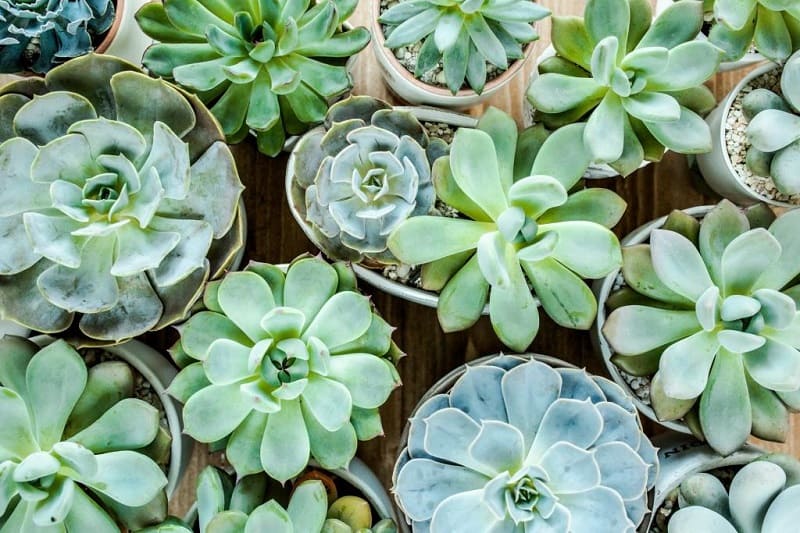
Succulents can survive in harsh conditions, but they are also prone to illnesses and infections. A common affliction is etiolation, which is an abnormal growth pattern in succulents. The plants look bent, leggy and stretched out, instead of being compact. Read on to learn how to resolve this, as well as other insightful information on succulent etiolation.
How to fix succulent etiolation
You can trim down your etiolated succulents to make them look normal again, but you cannot entirely return the distorted plants to their usual and normal form. There is no way to reverse the stretched and leggy appearance of affected plants.
Aside from trimming, you can place the plants near a window to get some sunlight, and gradually increase the amount of sunlight they receive to 30 minutes daily. You may also opt to use a grow light to help provide the amount of light needed by your etiolated plants.
Nevertheless, if you are no longer happy with how your plants look, you can always propagate them using the trimmings so you can grow aesthetically beautiful succulents. It only takes a few weeks for roots to form and offshoots to appear.
How to propagate trimmings of etiolated plants
These are the steps to propagate the trimmings of etiolated plants:
- First cut the crown of the plant, but make sure to leave at least one to two inches on the stem’s base and at least two to three leaves. Your plant is more likely to survive if you leave enough leaves to absorb sunlight.
- Allow the cuttings to dry and callus over. Calluses or scabs on the ends of stems are an indication that the cuttings are ready for planting.
- Finally, plant the callused end into the soil and water the newly planted cuttings.
The cuttings should be watered regularly until they develop roots. However, be sure to give just enough water and use a well-draining potting mix to avoid rot. Roots will start to develop after about three weeks. Once the roots appear, you do not need to water the plants often; once a week will do.
What causes succulent etiolation?
This pathological condition is due to light deprivation in succulents, although water and temperature could also be contributing factors. It is prevalent among indoor plants, and is a response mechanism to deficient sunlight.
Plants etiolate since they need sunlight to carry out photosynthesis, the process by which plants use sunlight to synthesize food from water and carbon dioxide. The process produces chlorophyll and generates oxygen as a by-product.
Plants that are deprived of light tend to stretch out and grow toward an area where they think they could obtain maximum light. As a result, succulents tend to have an elongated and bent appearance, and also look pale and weak due to the excessive energy spent on growing tall. Etiolation usually happens among plants kept for most of the day in dimly-lit areas inside homes and offices.
Common signs of an etiolated succulent
These are the common signs of etiolation:
1. The plant’s leaves are pointing downwards.
If you notice that the succulent leaves are drooping, the plant is likely etiolated. Certain varieties, like the Echeveria, are famous for their rosettes and upright leaf patterns. However, etiolated specimens have drooping leaves that eventually face downward. The reason for this is that the plant is adapting by creating a surface to acquire more light.
2. The succulent has a pale, bleached color.
The lack of sufficient sunlight prevents the plant from carrying out photosynthesis, which produces chlorophyll and gives the plant its bright green color. As a result, the plant looks pale, bleached or whitish.
3. The plant has a rapid, leggy and bent growth.
Succulent etiolation results in stretched-out, elongated growth, which happens rapidly. The leaves tend to space out and the plant cannot keep up with the formation of new leaves as it grows. The stem tends to become bent and weak out of the excessive energy spent finding the light. Weakened stems tend to break off and die.
How to prevent succulent etiolation?
Here are some preventative measures to avoid succulent etiolation:
- Make sure the succulents are near a brightly-lit, south-facing window. They require at least four to six hours of sunlight daily to grow well. However, make sure that you do not overdo it, since the plants may suffer from sunburn.
- Invest in a grow lamp if your plants are in an area where there is not enough sunlight. Grow lamps can provide photosynthesis wavelengths so the plants can continue to grow despite being in a dark area.
- Consider growing different varieties of succulents that are less prone to etiolation.
These are the rosette varieties that are more at risk of succulent etiolation:
- Echeveria
- Sedum
- Graptosedum
- Sedeveria
- Crassula
Conclusion
Succulents are hardy plants that thrive well despite getting very little moisture. However, they could become distorted, elongated and leggy because of insufficient sunlight. What you can do to fix succulent etiolation is to trim them and ensure that they receive enough sunlight, or provide a grow lamp to encourage photosynthesis. The last resort would be to propagate the cuttings so you can grow new and healthy plants.
Image: istockphoto.com / Katsiaryna Shautsova